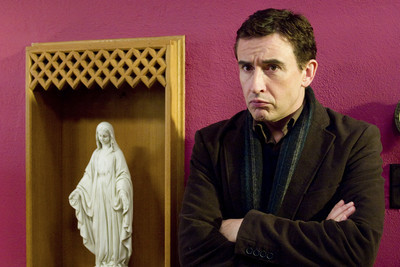‘What Goes Up’
When a movie's titled "What Goes Up," returning to earth is inevitable.
The question is what kind of landing we're in for: bumpy or smooth.
Both, it turns out.
Like its mostly teenage -- and mostly confused -- protagonists, it tries really, really hard to seem like it's not trying at all.
It thinks it's being profound when it's mostly being pretentious. (That is, when it's not being annoying.)
And it flails around as it desperately tries to solve its multiple identity crises -- and the meaning of same.
Yet despite the contrivances and frustrations (and there are more than a few), there's also something endearing -- and, occasionally, achingly poignant -- about "What Goes Up" and its gallery of valiant misfits.
Set in the days leading up to the 1986 Challenger space shuttle launch and explosion, "What Goes Up" begins with our introduction to Campbell Babbitt (Steve Coogan, "Night at the Museum's" noble Roman Octavius).
A cynical (are there any other kind?) reporter who makes the mistake of falling for an inspirational interview subject -- and compounds that mistake by fabricating stories about her -- Babbitt sinks ever deeper into a personal and professional funk.
Things get so bad his editor ("Third Watch's" Molly Price) decides to punish him (and, she hopes, shake and wake him up), by dispatching him to the New Hampshire hometown of "teacher in space" Christa McAuliffe.
It's the same town where an old college chum of Babbitt's lives.
Or, rather, used to live -- because Babbitt's college pal has suddenly, shockingly, fallen to his death, leaving behind a small but worshipful band of misfit teens who wonder how they'll ever survive high school horrors without the teacher who changed their lives.
Then again, maybe the new guy in their midst -- the seriously screwed-up Babbitt -- will prove equally inspirational.
Guess again. And keep guessing, because "What Goes Up" never quite figures out the answers.
Yet, in a way, that makes perfect sense -- because neither Babbitt nor the quirky locals he encounters seems capable of figuring out anything, much less the very meaning of life (and death).
That particularly holds true for the teens hit hardest by their teacher's demise -- and the inescapable onslaught of raging hormones. There's Lucy (Hilary Duff), whose friendship with her teacher might have been a bit too close for comfort. Jim ("The Wackness' " Josh Peck), struggles to deal with what being a man really means. And then there's Tess ("Juno's" Olivia Thirlby, Peck's "Wackness" co-star), whose hostility can't quite disguise her painfully apparent emotional scars.
If "What Goes Up" had been content to deal simply and directly with those emotional scars, it might have mustered some genuine impact.
But simple and direct simply won't do for writer-director Jonathan Glatzer, who collaborated with writer Robert Lawson on this adaptation of Lawson's play.
Instead, "What Goes Up" seems determined to throw in all kinds of distractions that keep the movie bouncing from earnest drama to raunchy teen sex comedy to pitch-dark satire to small-town weirdness.
Some off-kilter movies manage to keep their balance even while veering from one extreme to another, but director Glatzer doesn't bother trying to smooth out the glaring shifts in tone. (They're exacerbated by the space shuttle-sized shadow hanging over everything as we await the Challenger launch countdown -- and what's about to come crashing down on one and all.)
The movie's variable, all-over-the-map quality extends to the performances, which range from the cartoonish (who else but Molly Shannon as the high school's fussbudget music teacher) to the hypnotic (Thirlby, whose quiet intensity gives "What Goes Up" its most affecting moments).
Duff dutifully tries to thread her way through the emotional minefield of her role, but TV's erstwhile "Lizzie McGuire" can't always convey the emotions behind the conflicts. (It's not all her fault; if it ain't on the page, it ain't on the (sound)stage.)
And while the hilarious Coogan's deadpan sarcasm is always welcome, he's less comfortable when things get strained and/or strange.
Because that's most of the movie, he -- and we -- spend most of "What Goes Up" waiting for things to come crashing down. Which, inevitably, they do.
Contact movie critic Carol Cling at ccling@reviewjournal.com or 702-383-0272.
Carol Cling's Movie Minute
Review
"What Goes Up"
104 minutes
R; sexual situations, profanity, drug use, all involving teens
Grade: C
at multiple locations
Deja View
Adolescence (and adolescents) can make you do seriously strange things, as demonstrated by the young (and not-so-young) people in these titles:
"If ..." (1968) -- After a summer in Swinging '60s London, a public school student (Malcolm McDowell) returns to his brutally repressive private school -- and declares war on the powers-that-be. (Or does he?)
"Heathers" (1988) -- Bitchy members of a high school clique get their collective comeuppance from a new member (Winona Ryder) who falls for a rebellious transfer student (Christian Slater).
"Election" (1999) -- A high school teacher (Matthew Broderick) sets out to derail the campaign of an obnoxious overachiever (Reese Witherspoon) running unopposed for class president in this wicked satire.
"Ghost World" (2001) -- After high school graduation, an iconoclastic teen (Thora Birch) becomes increasingly alienated -- and attached to a geeky record collector (Steve Buscemi).
"The History Boys" (2006) -- Two very different professors (Richard Griffiths, Stephen Campbell Moore) try to prepare eight classroom cut-ups (led by "Mamma Mia's" Dominic Cooper) for college entrance exams in this adaptation of Alan Bennett's Tony-winning play.
-- By CAROL CLING














